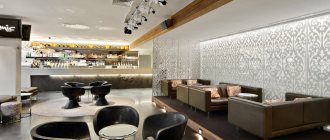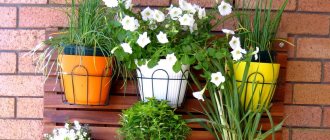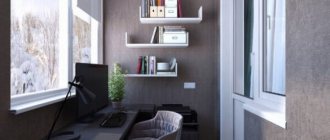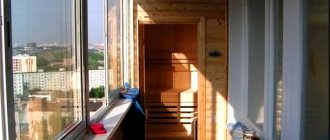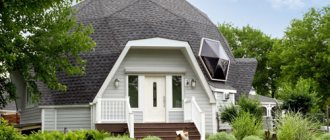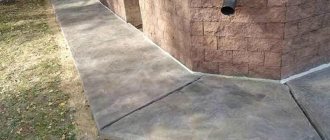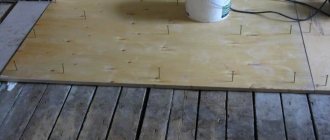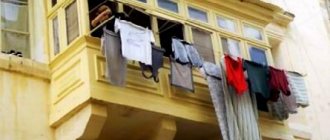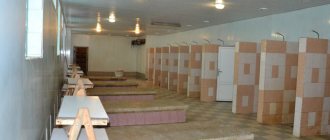When arranging a balcony, finishing materials, including flooring, play an important role. The floor must fully correspond to the type of room, otherwise there can be no question of comfort. The range of flooring materials is unusually wide, and making a choice is not always easy, especially for someone inexperienced in construction matters. That is why, before starting repairs, you need to choose the right type of coating.
How to lay the floor on the balcony
Requirements for floors on balconies
Balconies can be open or glazed, which means that the requirements for flooring will differ significantly. Much depends on how the balcony is used: as a relaxation area, a study, a greenhouse or a warehouse for unnecessary things. In each specific case, you need to take into account the operating conditions so as not to make a mistake when choosing materials.
Open balconies
Open balconies
The floor on an open balcony is constantly exposed to temperature changes, exposure to sunlight, rain and snow. Therefore, the floor covering must have high strength, frost resistance, not absorb moisture, be easy to clean from dirt, be non-flammable and non-slippery. Such requirements greatly limit the choice of materials, but it is still quite wide: ceramic tiles and porcelain stoneware, rubber tiles, decking, special rubber paints, PVC panels. Linoleum is also suitable for balcony floors, but not ordinary, but frost-resistant, which appeared on the construction markets not so long ago.
Closed balconies
Closed balconies
On glazed balconies, the floor is protected from rain and snow, fades less in the sun, and is less dirty. The most important factor here is the presence or absence of heating. A heated, insulated balcony is practically no different from a living room, and any covering can be laid there. If the balcony is not heated, but is insulated, the floor covering must withstand temperature fluctuations in winter and summer. If the balcony is simply glazed, without insulation of the walls and floor, the floor covering must be frost-resistant.
Balcony operating conditions
Relaxation corner with soft rug
When planning to create a relaxation area on the balcony, choose a material that is pleasant to the touch, environmentally friendly, but at the same time resistant to abrasion and ultraviolet rays. If you do not plan to have a warm floor underneath the covering, you should not lay tiles or make a self-leveling floor - such a surface will be very cold. It is better to use laminate, any wooden coverings, or linoleum on a thick backing.
Linoleum on the balcony
Any practical covering is suitable for a work office, not necessarily expensive or overly decorative. The material should be easy to clean from dust, not emit harmful fumes, and not be pressed under the legs of a table with a computer or other furniture.
Office on the balcony. Covering: ceramic tiles
If you plan to arrange a mini-greenhouse or winter garden on the balcony, the floor must be waterproof. When watering and replanting plants, water often spills on the floor, soil, and flower fertilizers get in. It is very easy to slip and fall on a dirty wet surface, which means you also need to choose an anti-slip coating.
Balcony - greenhouse. On the floor there is fine gravel and wooden boards
In the case when the balcony is used as a warehouse, it is best to cover the floor with an easy-to-care material that is not afraid of temperature changes and mechanical stress. It can be ordinary tiles or the same linoleum. It is not practical to lay expensive decorative materials on such a balcony. So, knowing the list of requirements for floor coverings, you should study in more detail the properties of the most popular materials.
Tips for choosing a floor according to the type of balcony
The flooring material should be selected taking into account its characteristics and features. It must be durable, high quality, easy to install and repair, and fairly light. You should also take into account the condition of the load-bearing slabs of the balcony. If they have lost their strength over the years, do not overload them. Any material from an extensive list will retain its original appearance and properties only if used correctly.
For an open balcony
You can protect the cement coating from damaging moisture by applying any finishing coating. Dust and debris will not accumulate on such a balcony. For open-type balconies, it is necessary to form an inclined layer from the wall. This will ensure free flow of water. It is better to carry out external finishing work with the following materials:
- Enamels and paints;
- Self-leveling floor;
- Terrace board;
- Ceramic tile;
- Porcelain tiles.
For a glazed/warm balcony
For a glazed balcony with heating, the choice of materials is much simpler. You can cover it with expensive, decorative materials for floor decoration. In order for the flooring to last longer, it should be separated from the concrete screed by at least a sheet of plywood. Mineral wool and expanded polystyrene are suitable as insulation. You can also use an electric floor. The finishing coating can be anything, even the most unusual for such a room:
- Carpet;
- Parquet;
- Laminate;
- Cork covering;
- Linoleum of any type.
Tile
The advantages of tiles are obvious:
- highly decorative;
- long service life;
- strength;
- frost resistance;
- resistance to chemicals;
- environmental friendliness;
- absolutely non-flammable.
Tiles for the balcony
It is easy to care for; installation, although it requires some skill, is not particularly difficult. All this makes tiles an almost ideal floor covering for a balcony. To reduce the load on the floors, lightweight tiles are produced, and for open balconies there are a lot of options with a rough anti-slip surface.
Balcony floor tiles
Flaws:
- tile floors are cold to the touch, so on closed balconies it is recommended to lay them on top of underfloor heating systems;
- The surface of the tile has very low sound insulation, and when walking there are booming sounds from steps.
The range of floor tiles is unusually wide; models differ in manufacturing method, decorativeness, size, presence or absence of glaze.
Ceramic or tile
Tile
This type of tile is considered the most common. It consists of a mixture of sand, clay and modifying additives, pressed and fired at high temperature. After cooling, a decorative glaze coating is applied to the surface of the tiles, which gives the tiles such an aesthetic appeal.
Porcelain tiles
Laying porcelain tiles on the balcony
When making porcelain stoneware, the working mixture is fired at higher temperatures than tiles, so the finished material has an external resemblance to natural stone and has the same technical characteristics in terms of frost resistance, strength, and durability. Porcelain stoneware is produced both in pure form and with a glazed coating; it looks very decorative, but is a rather expensive material.
Clinker tiles
Clinker tiles
This type of tile is durable, very wear-resistant, and is not afraid of moisture and freezing temperatures. This coating is ideal for an open balcony; moreover, the cost of clinker tiles is lower than porcelain tiles.
There are several other types of tiles, among which Cotto and quartz vinyl tiles are worthy of attention; each variety has its own characteristics. To make this coating look most impressive, follow several important rules when choosing.
Clinker tiles Feldhaus klinker, Stroeher
- Large tiles visually make the balcony smaller, so the smaller the area, the smaller the tiles should be. For balconies of standard size, experts recommend choosing 40x40 cm tiles.
- Dark colors also visually make a room smaller, while bright and light shades make it feel more spacious. This is especially important for balconies located on the north side, where there is too little light.
- For a glazed and insulated balcony, you should purchase tiles with wear resistance class PEI 3. The higher the rating, the more massive and heavier the material.
- Tiles should be purchased at one time, and with a small margin - about 5-7%. The tiles from the second batch may differ slightly in color, and if you suddenly have to buy additional material, the coating will be uneven.
Insulation materials
In a country cottage, if you are laying the floor on a balcony or veranda on the ground, there are many options for insulation:
- expanded clay;
- sawdust-clay mixture;
- ecowool;
- mineral wool;
- polystyrene foam, etc.
Not all materials are acceptable in urban environments. For example, a mixture of clay and sawdust or expanded clay will have to be laid in a thick layer, and this will sharply reduce the height of the balcony. Let's consider several insulation materials, more or less universal:
- Penofol (foamed polyethylene + foil) performs two functions at once: heat-insulating and heat-reflecting (the material is laid with the foil side up). The maximum thickness of penofol is 1 cm.
- Styrofoam. Cheap material, good thermal insulation, low hygroscopicity. Disadvantages - flammability (you should choose modifications with fire retardant treatment) and large thickness (since the density is low, the layer thickness can reach 10 cm or even more). Polystyrene foam is recommended if you plan to lay a heated floor over joists: the slabs are laid between the joists in a spacer on a waterproofing substrate. All cracks and gaps must be filled with pieces of the same material.
- Expanded polystyrene (PPS) and penoplex. More dense modifications of the same foam. Thickness up to 5 cm, low hygroscopicity and thermal conductivity. Generally low flammability. The main disadvantage is the same as that of polystyrene foam: when burned, these materials are toxic.
- Stone wool. The thermal insulation properties are somewhat worse than those of foam plastic. High hygroscopicity: when using mineral wool, not only a waterproofing substrate is required, but also a vapor barrier layer on top. The layer turns out to be quite thick, also recommended for laying between joists. Pros: non-flammable and affordable price.
Foamed polyethylene with foil layer
Polystyrene foam is the most affordable material
Penoplex plates
↑ back to contents
Linoleum
Linoleum
Advantages of linoleum:
- great variety and decorativeness;
- ease of installation;
- ease of care;
- relatively low price;
- water resistance.
Modern types of linoleum are characterized by increased resistance to abrasion, fade less in the sun, and are more resistant to aggressive substances.
Linoleum is an inexpensive and practical coating
Flaws:
- short service life;
- some species emit harmful fumes;
- when the temperature drops, linoleum loses flexibility and may break;
- deformed under the influence of mechanical loads.
Some types of linoleum can even be laid on open balconies
Traditional types of linoleum are not intended for installation in unheated rooms, especially on open balconies. But thanks to the development of technology, frost-resistant linoleum has appeared, as well as coatings with an anti-slip surface. Add to this the aesthetic appeal of the material - and you get an excellent coating for a balcony, regardless of its type and the presence of heating. Of course, the cost of such linoleum is higher than usual, but not by much. Linoleum can be baseless, as well as on a jute and foam base.
| Linoleum base | Description |
| Baseless linoleum | This material is characterized by a homogeneous structure throughout the entire thickness of the layer. This means that during long-term use the coating will not fade and the pattern will not be erased. Some models have a rough surface, so the risk of slipping is minimal. The thickness of such linoleum is 3 mm, and it must be laid on a carefully prepared, even base. |
| Foam based | This type of linoleum is considered the most durable and easy to use. Due to its immunity to moisture, it can be used in absolutely any room. On a closed, insulated balcony, such a coating will easily last up to 10 years with proper care. |
| Jute based | The thick jute base retains heat well, so this linoleum is quite suitable for a glazed balcony. It can be laid directly on a screed, self-leveling floor, as well as raised floors made of chipboard or plywood. This type of coating cannot be used on open balconies. |
Types of flooring
There are several floor finishing options.
↑ back to contents
Tile
Ceramics, tiles, clinker, porcelain stoneware. The best option for both installing heated floors and covering a cold, unglazed balcony.
- When installing an infrared floor, waterproofing (membrane or polyethylene) is placed on top of the film, and a thin sheet of plasterboard or moisture-resistant plywood is placed above it. The sheet must be strong enough to withstand loads, but as thin as possible, because both of these materials are heat insulators and reduce the efficiency of underfloor heating ;
- To tile a cold balcony, you also need a solid base. If the floor is concrete, it is enough to level it with sand-cement mortar; if there are logs, put plywood or fiberboard.
Advantages of tiles:
- mechanical strength;
- water resistance;
- heat resistance;
- hygiene, ease of care;
- many design options;
- for heated floors – excellent thermal conductivity.
For insulated balconies without heated floors, the last property of the tiles is a serious disadvantage: the floor will always be cold. In this case, you can prefer wood materials - boards, laminate.
Ceramic tiles on the balcony floor
Material requirements:
- floor tiles are marked with a foot icon. For high loads - a shaded foot icon, but such products are designed for floors in public institutions, in places with high traffic;
- anti-slip properties. Floor tiles are most often matte, rough, embossed or notched. If you are going to cover the floor on an open balcony, where it will be watered by rain, this condition is important. It is also recommended to take it into account if there is a small child or a person with disabilities in the house;
- For open balconies, an important characteristic is water absorption. The lower it is, the higher the frost resistance of the coating.
↑ back to contents
Terrace board
An excellent option for open balconies: minimal weight, environmental friendliness. The deck boards have already been treated with antiseptics and water repellents; there is no need to worry about rotting and fungus.
Photo: decking board on the balcony
In addition to wooden boards (made of heat-treated hardwood), there is a composite board (wood + polymers). The coating is also suitable for glazed loggias, but it has a serious disadvantage: its high price.
↑ back to contents
Planed board
Suitable for a glazed balcony, and in the presence of hydrophobic impregnations - also for an open one. When using any wood materials, be sure to take care of antiseptic treatment . There are profile boards with already sawn tongue-and-groove locks. They do not require additional fastening with hardware.
The best choice (but the most expensive) are oak and yew boards. Linden, pine, cherry are soft woods, such a floor will last less. A compromise option is birch.
Photo: planed board on the balcony floor
Plank coverings outperform others in many respects - ecology, heat-protective and noise-proof properties, strength. Their disadvantages:
- cannot be used for heated floors due to low thermal conductivity;
- To install a plank floor, it is necessary to lay logs, and this will reduce the height of the balcony.
↑ back to contents
Laminate
Inexpensive, practical, hygienic coating. The material is almost universal: it can be placed on heated floors too. There are special brands of laminate for heated floors: their thermal conductivity is lower and their heat resistance is higher.
Photo: laminate flooring on the balcony
The same requirements apply to the substrate.
Dark laminate
Laminate flooring is laid on heated floors using the floating method (dry). Unlike tiles: they are laid on glue. Therefore, laminated floors are easier to install and, if necessary, easier to dismantle.
↑ back to contents
Linoleum
Cheap, hygienic and easy to care for. If the floor is concrete, this is the easiest finishing option. Suitable for glazed balconies. It is better not to use for open ones: almost all types of linoleum are sensitive to ultraviolet radiation.
Photo: linoleum on the balcony floor
Can be laid on warm floors. Keep in mind that only one type of linoleum is compatible with heated floors: multilayer heterogeneous. This material has a fabric base, the backing is foamed PVC. All layers have the same thermal expansion, the coating will not deform when heated. Other types do not have this property.
Linoleum with a parquet pattern
Linoleum for heated floors, like laminate, is marked accordingly. But since identification marks vary between brands, it is better to clarify this issue with the seller.
↑ back to contents
Painting
When installing a wooden floor, painting is necessary: it will give the coating an aesthetic appearance and provide additional protection against rotting.
It is also better to paint the concrete surface if you do not plan to lay anything. Before painting, the concrete base must be leveled and all cracks and cavities must be sealed.
Painting the wooden floor on the balcony
Which paintwork materials are suitable for our purpose:
- wood can be painted with alkyd varnish. UV resistance, moisture resistance, temperature resistance. Suitable for both outdoor and indoor use;
- polyurethane paint or varnish. Suitable for both wood and concrete. Durability, water resistance, ease of application;
- acrylic paints are universal: suitable for interior and exterior work, for concrete and wood. UV resistance, water resistance, frost resistance, durability, good covering power. Minus – not the lowest price;
- Oil paints are a cheap way to paint a wooden floor on an outdoor balcony. It is better not to use indoors, because... This is not the most environmentally friendly coating and it does not “breathe”. In terms of durability, oil paint is inferior to acrylic paint;
- A good option for painting a wooden floor is Aqualak. It has the highest moisture resistance.
Note. There are certain temperature restrictions for operation, they are indicated on the packaging.
Coating a wooden floor with waterproof varnish
↑ back to contents
Garden parquet
Garden parquet
Garden parquet, decking, decking - all these are names for very practical and decorative coverings made of wood-polymer composites or very hard wood.
Advantages:
- low weight of the coating;
- water resistance;
- weather resistance;
- aesthetics;
- ease of installation.
Garden parquet (decking)
The coating is produced in the form of compact modules that can be laid on logs or mounted on a flat surface, connecting like a construction set. The only disadvantage of decking is its cost, since not everyone can afford it. Garden parquet is suitable for floors on both open and glazed balconies, goes well with any type of decoration and gives the room a touch of originality.
PVC tiles
PVC tiles
Vinyl tiles are an excellent solution for an enclosed balcony. Thanks to the variety of colors, you can independently create an original pattern on the floor that will decorate your balcony.
Advantages:
- ease of installation;
- water resistance;
- non-flammability;
- resistance to aggressive substances;
- highly decorative;
- small thickness;
- durability;
- environmental friendliness;
- practicality.
PVC tiles - a variety of shades and textures
In addition, the top layer has antistatic and anti-slip properties. The material is easy to cut, and therefore, when laying, you can even make an applique on the floor by choosing the appropriate pattern. There are plain models, wood, marble, and other natural materials. No glue or mastic is required to attach the covering to the base: the bottom layer of the tile is self-adhesive.
The material is laid on both a wooden and concrete base, the main thing is that it is as level as possible. If you have a wooden floor on your balcony, you can freshen up the interior by laying tiles on top of the boards. Such repairs will take a minimum of time, and the result will be very impressive. If laying is done on a cement screed, first grind and clean the surface from dust, then prime it. When installed on a dusty or uneven substrate, the quality of the coating will be very poor.
| Name | Characteristics | approximate cost |
| Bamboo parquet | Durable, wear-resistant, environmentally friendly material | from 1950 rub./m2 |
| Marmoleum | Non-flammable waterproof material with high decorative properties | from 980 rub./m2 |
| Liquid tile | Unique coating with 3D effect, impact-resistant and UV-resistant | from 14990 RUR/m2 |
| Leather tiles | Elite coating with high decorative properties, strong and durable | 2500-4000 rub./m2 |
| Glass floor | High-strength non-flammable coating, resistant to abrasion, mechanical stress, and chemicals | from 4000 rub./m2 |
Laminate
Laminate
Laminate can only be used on closed balconies with good waterproofing. Some types of laminate are even suitable for laying on heated floors. This coating is durable, has an aesthetic appearance, and if the panel is damaged it is easy to replace. The main condition for installing laminate flooring is a flat, smooth surface, which means that the base must be properly prepared.
Laminate on the balcony
Advantages of laminate:
- withstands long-term loads;
- does not fade in the sun;
- tolerates temperature changes well;
- fireproof;
- Resistant to chemicals.
The range of laminate flooring is very wide, the colors and textures are incredibly varied. You can easily choose a covering to match the interior of your balcony.
Laminate classification
Which laminate to choose
Other types of coatings
Very often, floors on closed balconies are made of wood. Both ordinary boards and wooden lining give the balcony a very cozy, lived-in look and saturate the air with the smell of wood. Of course, natural wood is expensive and requires high-quality protection from moisture. In addition, the wooden surface must be periodically treated to restore the structure. But at the same time, the tree is not afraid of freezing, it is durable and does not contain harmful substances. This coating is suitable for closed balconies, both insulated and not insulated, as well as for heated balconies, but only if it is not a heated floor system. When installed on a heated floor, the wood becomes deformed under the influence of heat, dries out, and begins to creak.
Wooden floors
Another good option for a closed, insulated balcony is carpet. This coating is soft and cozy, pleasant to the touch. If the balcony is used as a relaxation area, carpet will be an ideal option for arranging the floor.
Carpet
If the balcony is open and you have no desire to tinker with tiles or porcelain stoneware, use rubber paint for the coating. It does not fade, adheres firmly to the base, does not wear off for a very long time, and is not afraid of water, frost, or summer heat. To apply paint use brushes, rollers or a spray gun. The most important thing is to properly prepare the base. To do this, the concrete screed is leveled as much as possible, ground, and treated with a primer. Please note that even small errors under a layer of paint are clearly visible, and this reduces the attractiveness of the floor.
The floor is covered with rubber paint
Rubber paint was named so because the film formed on the surface of the paint is very flexible; if desired, it can be rolled into a small tube
There are many other coverings that can be used to cover a balcony, and it’s quite difficult to describe everything. The listed materials are the most popular and affordable; you can find them in any construction supermarket. In addition, each of the above-described coatings is easy to install independently, without resorting to the services of craftsmen.
Comparison table of floor coverings
| Type of coverage | Service life, years | Decorativeness | Ease of maintenance | Resistance to mechanical loads | Environmental friendliness | Maintainability |
| Parquet | 15-20 | average | average | not high | high | low |
| Linoleum | 3-7 | low | easily | not high | low | Can not be repaired |
| Tile | 5-15 | average | average | average | high | average |
| Carpet | 1-5 | low | hard | not high | low | Can not be repaired |
| Laminate | 3-7 | low | average | not high | low | Can not be repaired |
| Polymer | 10-30 | high | easily | high | high | high |
Video - How to lay the floor on the balcony
Preparing the base
Preparing the base is an important stage in finishing a balcony or loggia.
An ordinary building level will help to see the curvature of the floor on the balcony, but a screed will help to make the surface even.
- Purchase metal beacons, divide them into short sections with a width equal to the width of the balcony or loggia and place them across the entire space at a distance of 600 mm;
- The video will show you how to level the beacons;
- The beacons are fixed with cement mortar and work is postponed until the mixture has completely dried.
Important! If you need to finish an open balcony, then be sure to slope the floor towards the outside.
Afterwards, the usual formwork is required from beams, which are attached to the outside of the railing; the gaps between the beams must be covered. To prepare the mixture, it is better to buy a ready-made mixture that requires only water. Dilute, pour into formwork, level and let harden for about 2-3 days. After this, you should remove the bars and repair all the unevenness along the edges.
At this point, the finishing of the loggia or balcony can be completed, but often the owners do not want to leave the bare concrete floor and choose a final warm coating.
Important! Even for a concrete floor, a light screed will not harm. It will strengthen the base and allow it to maintain evenness and integrity for a long time.


